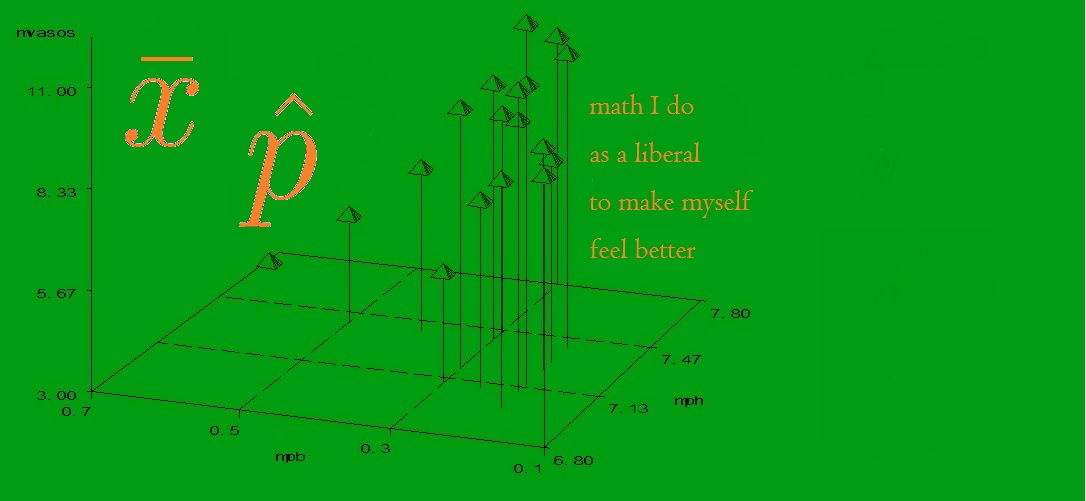I can't find the link to it now (read: I am super lazy), but I was reading a report about the large number of white people who have mostly (or exclusively) white friends. The number was around 90%, I think-- that is, the friend-circles of white people are made up of 90% other white people, among people living in the United States. The percentages weren't as high for members of other races (e.g., black people tend to have more white friends than white people have black friends, and so on). I wondered how I stack up.
Conveniently, I don't have a ton of Facebook friends, so it's not a difficult task for me to put them all in a spreadsheet and mark down everybody's race (as best I can). Turns out... damn. My friends are pretty dang white.
I have 177 Facebook friends*, of whom 156 (88%) are white, 8 (4.5%) are east Asian, 6 (3%) are south Asian, 4 (2%) are Hispanic, and 3 (1.5%) are black. These numbers don't reflect the racial makeup of the place I live: my wider metropolitan area is only about 57% white, and 29% of the population is black. While I am not FB friends with everyone I know in real life, I'm using my FB friend list as a reasonably representative sample of my wider social circle, for the purposes of this investigation-- the results of which don't reflect too well on me.
It's obviously weird to befriend somebody for the sole purpose of checking off a box on some "at least X friends of every race" list, but that doesn't mean that spending the overwhelming majority of my time around white people is a good thing. I feel like one of the best ways to stamp out your own unconscious biases is to surround yourself with people from races and backgrounds different from yours, as much as you can. The flood of information coming in every day from real-life interactions will hopefully overwhelm your internalized stereotypes, and re-wire your brain to accept lots of different people as normal without instinctively distancing yourself from the "other." I am not doing a very good job of that right now.
To get a closer look at the people I interact with regularly, I winnowed down my list of friends to a subset I nicknamed "face" friends: a list of 63 people whose faces I had physically seen within the past year. Here's how they break down:
Even whiter than before. 92% White, 3% Black, 3% South Asian, and 2% Hispanic. In retrospect, it makes sense: I went to a very diverse high school, but I haven't seen many of my high school friends in the past year. The college I went to had a student body white enough to have once been on the KKK's list of recommended universities (an honor of which the school was none too proud), so the folks from whom I could choose my college friends were mostly white. And until very recently, everybody on the small staff of my office was white. The general trend of my life has been to spend less and less time around people who don't look like me. Not a great trend : (
Counting up my number of friends, I wondered, do I have enough friends? Too many? How popular am I, compared to my friends? Excel does not like histograms, but if you arrange your data just so, you can trick it into making a bar chart that acts like a histogram. Here's what the distribution of popularity looks like, among my friends:

Number of friends is understandably skewed right: there's a hard minimum, but no real maximum to speak of. Among my friends, the average number of friends is 508. I'm waaaaay below that, though not technically a full standard deviation below the mean. Then again, a couple very popular friends of mine are pulling that average up, what with all their theatre- and activism-related networking and general likeability (those scoundrels). For a data set this skewed, the median is probably a better estimate of central tendency. The smallest number of friends any of my friends has is 10 (my uncle Jim), the first quartile goes up to 202 friends, the median is at 391 friends, the third quartile is 650 friends, and the absolute maximum is 2,661 friends (holy cow, Carlie, how can you even remember so many names?). Using my friends as a sample set, I have a pretty low number of friends-- I'm only in the bottom 25%.
What I don't understand is how my dad is so much more popular on FB than I am. I'm a dang millennial, but he can post a single photo that attracts more likes than I have friends. Aren't dads not supposed to know how to do the Face Book? I guess he is just a super cool DJ with lots of super cool rockin' friends, and I am a lowly mathematician, whose best friends are all imaginary numbers. I am such a disappointment.
(Just kidding, Dad, I know you love me. And even if you were disappointed that I did not turn out as cool as you did, I would understand.)
* Excluding my dear friends Marius Pontmercy and Billy Budd, who were just obscure enough to have survived the fictional-character-FB-page purge that spoiled all our fun back in high school.




